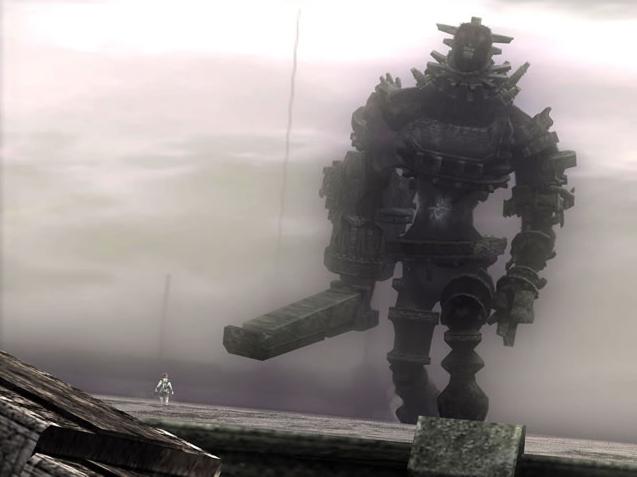Shadow of the Colossus

In Shadow of the Colossus, you assume the role of a young man trying to reverse the death of his lover. He travels to a temple at the end of the world and is tasked by a mystical voice to defeat 16 colossi to bring his beloved back to life.
These colossi are awesome, giant beasts made of stone, hair, and metal. Some tower over you like living skyscrapers and the ground cracks as they walk about. Though they have an unfamiliar shape, they aren't exactly monsters. You don't find them attacking villages or setting fields ablaze; they are most often pacing about a remote cove. While their scale is jaw-dropping, their gaze can leave the deepest impression; while some throw looks with squint-eyed malice, many look with open, empty eyes like a bear at a zoo.
Your quest to kill these creatures doesn't allow you the unassailable moral high ground as other games do. You are told to kill all 16 of these creatures to bring your lover back; exchanging sixteen (arguably) innocent lives for one. The player isn't given a choice to approach the problem any other way than to kill the creatures. There's a sequence to which colossus you have access to, so you have to defeat the current colossus to be able to see the next one.

In gaming terms, Shadow of Colossus is a series of boss battles. While some of these conflicts are immensely satisfying, the typical form of a boss battle can make it a trying experience. The game itself, in terms of action challenges, is relatively easy, but solving the puzzle of getting onto the creatures is either trivial or blindingly frustrating. As with all these types of encounters, determining the pattern and weak points is critical to success. If the solution comes quickly to you, it is simply a matter of execution. When you don't know what to do, the action comes to a stand-still and frustration sets in quickly.
Shadow of the Colossus is similar to the old adventure game genre in that when you're stuck on a puzzle, there's nothing else to do. At these points, the player either soldiers on trying everything they can think of to solve the problem, cave in and load up GameFaqs to solve the problem, or turn off the game, probably not to return to it again. As I played through, I slowly went from the good soldier to the GameFaq'er.
The camera during these battles sticks with you like a fickle friend. When you're on the right path and doing well, it's right there with you helping you along. If you're not exploring the right path, it tends to give you the worst possible view of the action, only adding to the frustration. Ico's camera had a similar tendency, but the slower pace and few time-based challenges absolved most of the frustration.
Many people are citing Shadow the Colossus as "art". Whether or not it is art depends on how broad your definition of art is. I have a very broad definition, so I believe all games are art, along with all tv shows, comic books, used car commercials, and newspaper coupons. I tend to value art according to three criteria: craftsmanship, what it reveals to us about humanity, and what it reveals to us about the medium. I believe Ico was a better crafted game that revealed how engaging a quiet, peaceful puzzle/maze navigation game can be. Aside from the moral positioning of the main character, most of what Shadow of the Colossus has to say isn't very interesting. It is well crafted in many ways (the design of the world, architecture, colossus design) but the fickle camera and the adventure game-style frustration make for a middle of the road play experience.

Comments